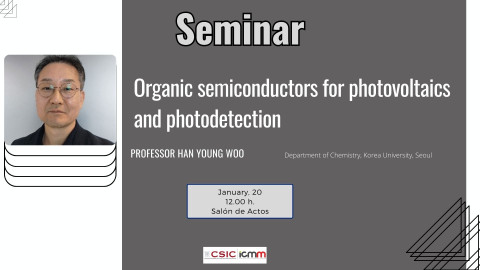
Author: Han Young Woo - Department of Chemistry, Korea University, Seoul
When: January, 20 - 12PM
Where: Assembly Hall, ICMM-CSIC
Abstract: In recent years, non-fullerene acceptors have emerged as promising alternatives to n-type materials, addressing the limitations of fullerene derivatives in tuning optical and electronic properties. Non-fullerene acceptors exhibit strong and easily tunable absorption characteristics, which is a significant advantage over fullerene-based structures, and have achieved photovoltaic efficiencies of up to ~20%. To further optimize organic solar cells (OSCs) as next-generation green energy sources, several key aspects must be carefully considered. This includes understanding the fundamental relationships between molecular structure, exciton diffusion length, film morphology, the suppression of non-radiative energy losses, and overall device performance in OSCs.
In addition to OSCs, organic photodetectors (OPDs) have garnered attention for their ability to detect and convert light into electrical signals using organic semiconducting materials. OPDs offer advantages over traditional inorganic photodetectors, such as solution processability at room temperature and the ability to easily tailor their spectral response through molecular design. The mechanical flexibility and versatility of organic materials further enhance their potential in wearable and portable devices. A critical performance metric for OPDs is specific detectivity (D*), which measures the detector’s sensitivity to weak optical signals amid background noise. Improving D* requires optimizing the photocurrent-to-dark current ratio, which demands a dual focus on minimizing dark current while maximizing photocurrent generation. Suppressing dark current is especially crucial for enhancing detectivity. In this presentation, I will discuss our recent strategies for dark current suppression, response time control, and the static and dynamic characteristics of OPD devices.

